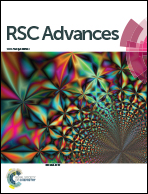Electrochemical catalytic activity study of nitrogen-containing hierarchically porous carbon and its application in dye-sensitized solar cells
Abstract
Nitrogen-containing hierarchically porous carbon is derived by carbonizing and activating polypyrrole nanostructure (APNP) using a template-free synthesis method and is demonstrated to be an efficient counter electrode (CE) in dye-sensitized solar cells (DSSCs). APNP exhibits an interconnected hierarchical pore structure with a pore volume of 0.52 cm3 g−1 and a large specific surface area of 707.98 m2 g−1. The material also displays a low degree of graphitization phase as well as numerous defects. The sheet resistance and conductivity of the APNP CE film are 2.05 × 103 Ω sq−1 and 35.86 S m−1, respectively. Electrochemical catalytic activity and photovoltaic performance studies demonstrate that APNP exhibits significant catalytic activity towards triiodide (I3−) reduction and shows power conversion efficiency (PCE) of 6.58%, which is comparable to Pt-based DSSCs (6.93%). We observed that, apart from improving the surface area and pore structure, the chemical activation process increases defect sites, conductivity and the graphitic N state, hence reduces the charge transfer resistance in the CE, and finally enhances the PCE of the DSSC.


 Please wait while we load your content...
Please wait while we load your content...